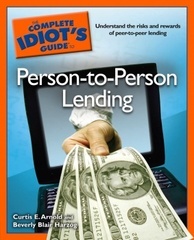Americans who find it difficult to get loans from banks can turn to the latest trend in loans: person-to-person (P2P) lending.
P2P loans are a form of social lending, or people lending to other people instead of going to a financial institution like a bank. P2P funds are available to help pay off a mortgage, start a small business and pay for college. Additionally, people are exploring the world of P2P lending for personal loans. Things like credit card debt, home improvement, auto costs, weddings, medical bills and even military deployment are being paid for through this online lending program.
Where can you go to get background on the P2P social lending phenomenon? As it happens, the newly-published “The Complete Idiot’s Guide to Person-to-Person Lending” bursts with information on the topic. The book includes a thorough explanation of the increasingly popular sphere of social lending. Focusing on information that is pertinent to lenders and borrowers, the book goes over the various companies and websites offering this service, different types of loans available under the P2P lending umbrella, and legal information and tax practices connected to the service.
All of the information is packaged in The Complete Idiot’s Guide tradition of bullet points, quizzes, charts, step-by-step guides and yes, even a cartoon or two.
In reading the book, I found out that P2P lending is referred to by several other names as well, including social finance or microfinance—but they’re pretty much all talking about the same thing. Introduced to America in early 2006, P2P lending is more than an alternative to banks. The book’s authors say “[it] has been thrust into the mainstream as a transparent, durable solution for America’s borrowers, investors and the economy as a whole.”
Authors Curtis Arnold and Beverly Blair Harzog contend that P2P lending is on the rise as the average American’s accessibility to bank loans falls. For the reader wary of this new trend, The Complete Idiot’s Guide compares banks and P2P lending. The overall verdict: it’s a safe way to go about loans. The pros listed in that section as well as lower interest rates and lower monthly payments make P2P lending attractive for lenders and borrowers alike.
P2P lending connects borrowers and lenders online, and a quarter of the book deals with navigating the most popular P2P lending websites and how to choose the best one for your needs:
- Prosper.com. Started up in 2006 and is currently the largest P2P lending site.
- Kiva.org and MicroPlace.com. These are microlending sites that allow you to loan small amounts of money to entrepreneurs in the U.S. and abroad.
- VirginMoneyUS.com. An off-shoot of Richard Branson’s Virgin empire, it is a leading site for loans between friends and family, especially for mortgages.
- Nolo.com. Tied to the Nolo publishing company, this site offers good information for borrowers and lenders.
- Fynanz.com and GreenNote.com. Good sites dedicated to college loans.
- Best of The Rest: LendingClub.com, GlobeFunder.com, Loanio.com and LoanBack.com
Many P2P sites out there use WebBank to handle their money flow. Based in Salt Lake City, it is FDIC-insured bank that follows federal law regarding licensing issues. It also does some small financing projects like P2P lending. WebBank is partnered with Prosper.com and LendingClub.com, so if the idea of P2P lending makes you nervous, try a FDIC-backed site to ease your mind.
Read more about different types of loans: Fund College With PLUS Loans







Leave A Comment